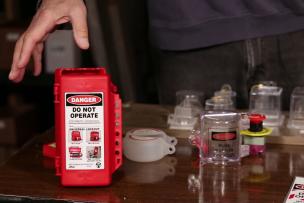The identity of each chemical, and all relevant information concerning the potential hazards of each material, must be clearly posted, and employees who work with workplace chemicals must be trained to interpret chemical labels, according to OSHA’s revised hazcom standard that aligns with the Globally Harmonized System, (GHS) This article will provide five tips to help your company stay compliant and safe.
Excelling at Chemical Safety - Five Tips to Identify & Communicate Risks
The identity of each chemical, and all relevant information concerning the potential hazards of each material, must be clearly posted, and employees who work with workplace chemicals must be trained to interpret chemical labels, according to OSHA’s revised hazcom standard that aligns with the Globally Harmonized System, (GHS) This article will provide five tips to help your company stay compliant and safe.
Safety data sheets (SDS) organization
Safety data sheets (SDS) are required for each hazardous chemical in a workplace. SDSs provide crucial information about each chemical, including the identity and properties, potential health hazards, necessary protective measures, as well as instructions regarding storing, handling, or transportation. OSHA Standard 1910.1200 App D sets the minimum information requirements for SDS, which now must be presented in an easy-to-review 16-bar format. Here is a brief list of helpful organizational tools if you go with paper SDS as opposed to a computerized SDS database:
SDS Binders: Binders can store several safety data sheets in the same place, and are easy to sub-organize with tabs. Workers are required to have immediate access to chemical information, so organization is especially important. Binders, generally made with a strong plastic cover, also protect them from the wear and tear of a busy workplace.
SDS Stations: SDS stations provide a centralized location for safety data sheets. Stations are usually mounted to a wall and store two or more SDS binders, and may also contain training booklets or other relevant materials. Stations generally have easy-to-see text and color schemes, making it easy to find from any location. If workplace is especially large, projecting signs that identify SDS centers are often used in tandem with stations. If your workplace uses several hazardous chemicals, SDS stations are a good choice.
Wire Wall Racks: Wire wall racks are essentially sturdy baskets which house SDS binders. Like SDS stations, they are generally mounted to a wall, providing a centralized location for chemical information. While they don’t provide the same visibility, wire wall racks can be an effective, lower-cost alternative to stations.
Graphics and visuals
Signs and posters are an easy, cost-effective way to convey chemical safety information. Many workers respond especially well to graphics and visuals. Posters can convey critical safety information in an easy-to-understand, intuitive manner, and can provide a powerful supplement to safety data sheets. Location-specific posters can also keep safety priorities top of mind, directly at the sites where they are most needed.
Train annually
The primary goal of training is to teach workers how to safely handle all potentially hazardous chemicals present in a given workplace. Workers must understand the format of safety data sheets and be able to easily find relevant information. Training should be done at least annually, in order to ensure continual effectiveness. Training also needs to reoccur whenever a new hazard is introduced into a workplace.
It should be noted that a new chemical is not necessarily a new hazard; for instance, if a corrosive chemical is introduced into a workplace that already contains corrosives, no extra training is required for that chemical. If a new chemical belongs to a new hazard category, then workers need to be trained in regards to the hazards of that chemical.
The manner in which hazcom and safety data sheets are explained is up to the employer to a degree; OSHA only requires that training is comprehensible and effective. Training may occur in the form of lectures, audio-visuals, online, videos, or classroom instruction. The best way to train can vary from one workplace to another and is dependent in part upon specific workforce needs.
It is a good idea to mix audio, visual, and interactive approaches, so that workers of all learning types can become proficient. A section of training should also be devoted to answering workers’ questions, in order to make sure that workers are confident in their knowledge. Ongoing communication between workers and management should also be encouraged, so that any questions that arise after training has occurred can be addressed immediately.
Scanning & tracking
All hazardous chemicals are required to be inventoried; the challenge consists of keeping track of chemical information efficiently. A system needs to be developed in which all chemicals can be tracked. All containers should have barcodes, so that all relevant data about a given chemical can be retrieved by scanning the barcode. In the event that a label becomes damaged or otherwise illegible, this provides a solution. All data should also be electronically backed up, and easily retrieved if necessary.
Standardize labeling
Labeling should remain the same on primary and secondary containers. Primary containers are the drums, barrels, bottles, or other containers that are received directly from the manufacturer. In contrast, secondary containers hold chemicals that are transferred from primary containers, and are generally smaller. Using the same label formats, including the same pictograms, is the most efficient way of labeling chemical containers. Using the same label allows workers to avoid having to learn more than one label format per chemical, and makes it easier to identify the transfer of hazardous chemicals.
Organization and training are common themes throughout these tips. A commitment to organizational products, thorough training, and efficient inventory techniques will help your company excel at chemical safety.
Previously featured on the ISHN site. Eric Prinzing is senior copy editor at Zing Green Safety Products, a manufacturer of sustainable safety products in Oswego, IL. The product line includes signage, lockout/tagout, padlocks and more.



Talk to Us!
Leave a reply
Your email address will not be published. Required fields are marked *